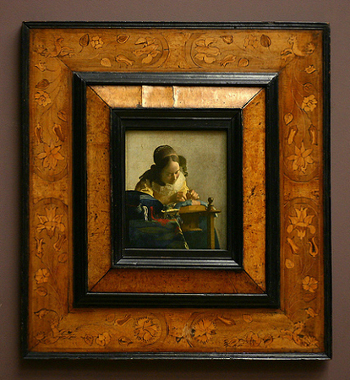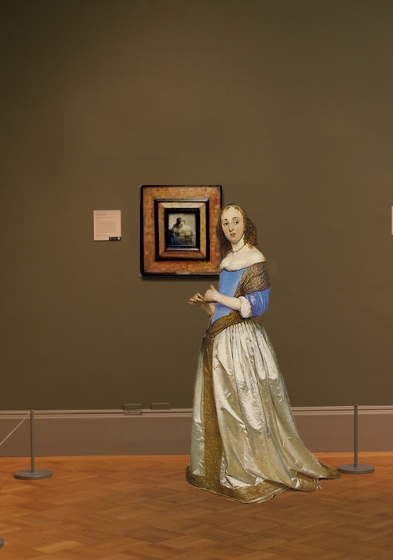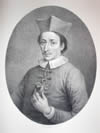The Lacemaker
(De kantwerkster)c. 1669–1671
Oil on canvas (attached to panel), 24.5 x 21 cm. (9 5/8 x 8 1/4 in.)
Musée du Louvre, Paris
inv. M.I. 1448
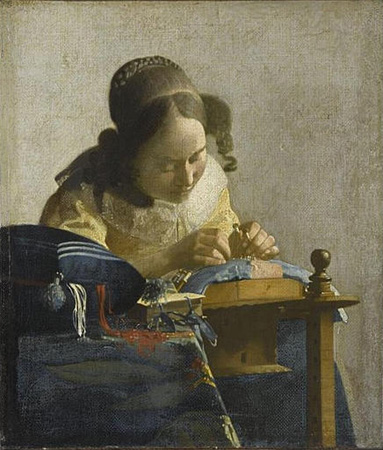
The textual material contained in the Essential Vermeer Interactive Catalogue would fill a hefty-sized book, and is enhanced by more than 1,000 corollary images. In order to use the catalogue most advantageously:
1. Scroll your mouse over the painting to a point of particular interest. Relative information and images will slide into the box located to the right of the painting. To fix and scroll the slide-in information, single click on area of interest. To release the slide-in information, single-click the "dismiss" buttton and continue exploring.
2. To access Special Topics and Fact Sheet information and accessory images, single-click any list item. To release slide-in information, click on any list item and continue exploring.
The blue sewing cushion
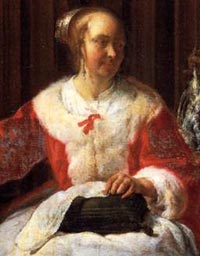
The Hunter's Gift (detail)
Gabriel Metsu
1658–1660
Oil on canvas, 51 x 48 cm.
Rijksmuseum, Amsterdam
The blue cushion with decorative tassels in the foreground is a naaikussen (sewing cushion), a common object in the 17th-century Netherlands. The naaikussen, made of rigid material and covered with velvet or cloth, housed compartments that stored various sewing accessories. In Vermeer's depiction, an abundance of red and white threads spills out from the cushion's opening. Such cushions were typically held on a young lady's lap, serving as a foundation for her sewing tasks.
Costume specialist Bianca M. Du Mortier notes that from the 16th century onward, the naaikussen became emblematic of the diligent, virtuous woman. Such women dedicated themselves to needlework and refrained from frivolous pursuits. Interestingly, extant naaikussens feature a lock at the front, suggesting that these sewing cushions might have also safeguarded jewelry. Some even boasted intricately designed interiors, classifying them as items of luxury. The more complex naaikussens were ingeniously crafted with two identical wooden halves. A fabric covering, which connected the halves, was padded and stitched firmly through uniform holes in the wooden edge. Given that the lining came from a single fabric piece, the two wooden sections appear sandwiched between the fabric layers.
The simpler variants of these cushions were designed chiefly to rest on the sewer's lap, providing a stable base for work.
The naaikussen not only served a practical function but also became symbolic of the values and virtues of women in the 17th-century Netherlands. By featuring this object, artists like Vermeer were likely alluding to the societal expectations and roles of women during this time. Needlework was not just a leisurely pastime but was seen as an essential skill for women, reflecting their discipline, diligence and devotion to household tasks.
The parchment-covered book
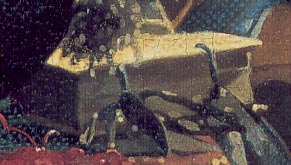
The small parchment-covered book on the table has been identified in various ways: as a prayer book, a small Bible (which, in this context, would symbolize domestic virtue, a central tenet of Dutch civil life), or a pattern book. The feather-like shapes in front of it are likely book ties, although they are depicted with such artistic interpretation that some observers mistook them for feathers. Art historian Albert Blankert highlighted the presence of a similar ribboned book in Quiringh Gerritsz van Brekelenkam's painting, Lacemaker and Patron (circa 1660–1665), where a standing gentleman, presumably a customer, compares a young girl's lace to a pattern book.
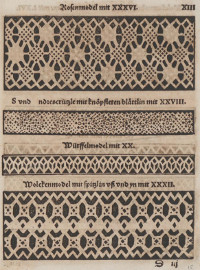
Nûw Modelbuch, Allerley Gattungen Däntelschn
(page XIII)
R. M.
Printed by Christoph Froschauer
Zûrich, 1561
The earliest known documentation of bobbin lace—clearly the type being made by Vermeer's Lacemaker—is the pattern book Nûw Modelbuch, Allerley Gattungen Däntelschn by an author identified only as "R. M." This book was printed in 1561 by Christoph Froschauer in Zurich. These pattern books indicate that bobbin lace didn't evolve from simplicity to complexity. Instead, they display intricate designs and diverse working methods from the outset. Beyond these two references, the next significant publication wasn't until Isabetta Catanea Parasole's Speccio delle virtuose donne (The Mirror of Virtuous Women), which came out in Rome in 1595. A challenge posed by these early pattern books is their lack of working instructions, leaving the interpretation of the patterns to the discretion of the lacemaker.
The strange table

New Modelbuch, von Allerhandt Art Nehens und Stickens (A Lace Guide for Makers and Collectors)
Nicolas Bassée
1568
Frankfurt am Main
The lacemaker sits at a rather complicated piece of furniture, a triangular table, for lace making. The stand in Vermeer's painting is a fancier model: the light platform, with scalloped carving on the underside, tapers towards the finial of the post. Peg holes allow the height of the platform to be adjusted. The wood panel below the platform has square holes and a scalloped foot or shelf at the bottom. It is evidently part of the stand and the uppermost surface could be raised and lowered by inserting a peg into one of the holes in the leg with the knob top. The rectangular post, iscrowned by a carved (detachable?) knob.

The precise form of the stand is not seen in other 17th-century sources, and no early examples survive. However, the general type is known from patternbooks such as Nicolas Bassée's New Modelbuch (1568), where one of the illustrations (featuring architectural details and a dog adopted from Dürer's Saint Jerome in His Study) shows a stand comprised of a single post and a tilted platform with a shelf at the front.
A smaller version of this type of stand supports the bobbin box used by Nicolaes Maes's Elderly Lacemaker. Similar stands can be seen in early photographs.
The tapestry covering the table
This tapestry bears similarities to those depicted in Vermeer's Love Letter and Astronomer. The slender leaves of the floral pattern suggest it wasn't an import from the Far East but rather a tapestry crafted locally, possibly in Belgium or the Netherlands. It's conceivable that it originated from Vermeer's hometown of Delft, known for its flourishing tapestry industry.
While today it's globally renowned for its iconic blue-and-white ceramics, at the time, Delft's tapestry workshops were also at the forefront of European textile artistry. Two figures dominated this scene: Maximiliaan van der Gucht and François Spiering.
Van der Gucht's tapestries were synonymous with excellence. His workshop crafted pieces ranging from grand narratives depicting historical or mythological tales to smaller decorative works that graced the walls of the wealthy, signifying both affluence and refined taste.
Meanwhile, François Spiering, emerging from a lineage steeped in tapestry-making tradition, brought his unique vision to the craft. His workshop was distinguished for its intricate designs, bursting with vibrant colors and unmatched craftsmanship. Spiering's innovative approach to tapestry-making often involved collaborating with prominent painters of his time, such as Hendrick Cornelisz. Vroom and Karel van Mander the Elder, integrating their designs into his works, creating pieces that were both textile and canvas. His creations weren't limited to the elite households of Delft. Royalty and high-ranking officials sought after Spiering's tapestries, a testament to their prestige.

Detail of wall with traces
of Vermeer's signature
To exalt the expressive tension of the young lacemaker engrossed in her task, Vermeer positioned himself close to the subject, leaving only a patch of blank white-washed wall in the background. Yet, the unobtrusive wall might possess its own narrative.
As art historian N. Rodney Nevitt Jr. noted, in a passage from Johan van Heemskerck's pastoral romance, Batavische Arcadia (Batavian Arcadia), a young Dutch traveler narrates his experiences in the Pyrenees where he discovered an inn operated by a fellow Dutchman. He states: "I was amazed to find there a neatness (in white-washed walls and other examples of Dutch cleanliness) to which my eyes had almost grown unaccustomed, for I had been abroad for a long duration." Throughout the 17th century, the Dutch were recognized—and often mocked—for their pronounced commitment to cleanliness. It's believed that the lime in their paint ensured optimal hygiene in spaces where beer and cheese were crafted.
The yellow satin garment
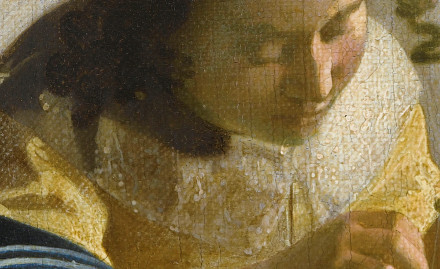
Vermeer's young lacemaker presumably wears a satin yellow garment with a lace collar. The collar is executed with pictorial freedom, making its decorative motif indistinguishable, even though the artist adeptly captures the material's transparency with remarkable economy.
Who posed for the painting?

Lady Writing a Letter with her Maid (detail)
Johannes Vermeer
c. 1670–1671
Oil on canvas, 71.1 x 58.4 cm.
National Gallery of Ireland, Dublin
While not a single sitter in Vermeer's paintings has been objectively identified, critics have asserted that some of them were likely members of his immediate family circle. Considering the probable date of this painting and the corresponding ages of the artist's eldest daughters Maria and Elizabeth, it would be normal for one of them to have posed for this picture. Sewing or lacemaking was integral to the upbringing of a virtuous young Dutch woman. In any case, the facial features of the present figure compare favorably to those of the young lady bent over a letter in a work of the same period, the Lady Writing a Letter with her Maid.
The lacemaker's hairstyle and falling locks, which costume experts tell us were in vogue for a limited number of years, confirm the date generally ascribed to the painting for stylistic reasons. The dangling locks resemble those of the Young Woman Seated at the Virginal, painted in the same years.
The unfocused threads
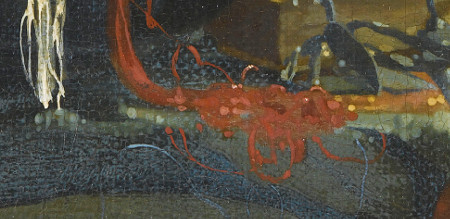
One of the most frequently discussed passages in Vermeer's body of work involves the red and white threads emerging from the opening of the sewing cushion. The threads have been rendered so loosely that if one had not encountered them within the painting's context, they might not be identifiable. This might have been even truer for Vermeer's contemporaries.
This dramatic departure from reality finds few counterparts in Dutch fine painting of the era. The threads appear intentionally out of focus when compared to the two taut threads the girl is working with, as well as a delicate blue thread that twists upon itself against the front of the carpet-covered table. Some have attributed this phenomenon to the artist's possible use of the camera obscura. Equipped with a single lens, the camera obscura possesses a remarkably shallow depth of field, which could have resulted in an image resembling Vermeer's distinctive portrayal. In further support of this theory, distinct sequin-like highlights, known in photographic terms as "halations" or "disks of confusion," are plainly visible in various parts of this artwork.
Making lace
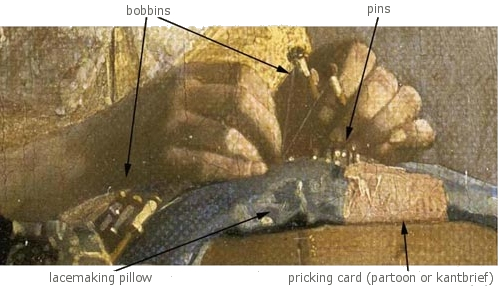
While the exact type of lace being created by the girl is not visible, some deductions can be made from the tools she employs, which Vermeer has depicted with sufficient precision. The girl's hands rest upon a rather flat, light-blue lacemaking pillow, now referred to as a "cookie-pillow" due to its rounded shape. This style of pillow was used to create shorter sections or stripes of lace. Another elongated, thick, tube-like "bolster-pillow"was commonly used for producing longer lengths of lace, although this does not appear to be the case in Vermeer's composition.
The light brownish pricking card ("patroon" or "kantbrief") is partially visible, affixed to the blue pillow. Historically, it was crafted from parchment. Although not explicitly depicted, small holes were punctured into this card to establish the intended pattern. Pins were meticulously inserted into each hole, around which the threads were skillfully intertwined. This preparatory phase was—and still is—extremely time-consuming, demanding undivided attention to prevent any errors that could compromise the entire work.
The diminutive silvery pins, casting their rounded reflections—bearing a striking resemblance to an optical effect produced by the camera obscura known as "halations" or "disks of confusion"—are discernible in Vermeer's portrayal, despite being somewhat abstracted. Around these pins, the threads, guided by the bobbins, are woven and crossed in accordance with the desired pattern. The primary movements encompass the "twist" and the "cross," while numerous other techniques are also employed.
special topics
Critical assessment
The achievement of Vermeer's maturity is complete. It is not open to extension: no universal style is discovered. We have never the sense of abundance that the depiction of jewels of his century gives us, the sense that the precious vein lies open, ready to be worked. There is only one Lacemaker: we cannot imagine another. It is a complete and single definition.
Lawrence Gowing, Vermeer, 1952
The signature

inscribed upper-left on the gray wall: IVMeer (IVM in ligature)
(Click here to access a complete study of Vermeer's signatures.)

Dates
1670–1671
Albert Blankert, Vermeer: 1632–1675, 1975
c. 1669–1670
Arthur K. Wheelock Jr., The Public and the Private in the Age of Vermeer, London, 2000
c. 1669–1670
Walter Liedtke, Vermeer: The Complete Paintings, New York, 2008
c. 1670–1671
Wayne Franits, Vermeer, 2015
(Click here to access a complete study of the dates of Vermeer's paintings).
Technical report
The support is a slightly open, plain-weave canvas with a thread count of 12 x 12 per cm. The canvas has been glued onto an oak panel measuring 23.9 x 20.5 cm. X-radiography reveals a line of tack holes and cracks from former fold lines at the left and right edges. Strainer bar marks are also evident on the sides, 2 cm from the fold lines. Along the top edge, the line of cracking is 1.4 cm from the edge of the canvas, and along the bottom edge, it's 2 cm. If we assume that the strainer bars were of equal width, this indicates that only the tacking edge has been removed from the bottom edge, and the tacking edge plus 6 mm from the top edge. This would mean original measurements of 24.5 x 19.3 cm, rendering the painting slightly narrower and taller than it is currently.
The thin, gray-brown ground consists of chalk, lead white and umber. The red, pink and light blue areas were painted wet-in-wet. Brush marks add texture to the background paint, and touches of impasto are evident on the highlights. An X-radiograph reveals a pentimento: the knee was positioned lower, revealing a triangle of wall beneath the tabletop. The blue in the tablecloth has discolored. The flattened tacking edges on the left and right sides have undergone retouching.
* Johannes Vermeer (exh. cat., National Gallery of Art and Royal Cabinet of Paintings Mauritshuis - Washington and The Hague, 1995, edited by Arthur K. Wheelock Jr.)
Provenance
- (?) Pieter Claesz. van Ruijven, Delft (d. 1674); (?) his widow, Maria de Knuijt, Delft (d. 1681);
- (?) their daughter, Magdalena van Ruijven, Delft (d. 1682);
- (?) her widower, Jacob Abrahamsz Dissius (d. 1695);
- Dissius sale, Amsterdam, 16 May, 1696, no. 12;
- Jacob Crammer Simonsz, Amsterdam (before d.1778);
- Crammer Simonsz sale, Amsterdam, 25 November, 1778, no. 17 (to Nijman);
- Jan Danser Nijman, Amsterdam (1778-before 1792);
- Jan Wubbels sale, Amsterdam, 16 July, 1792, no. 213 (to J. Spaan);
- Hendrik Muilman sale, Amsterdam, 12 April, 1813, no. 97 (to Coclers);
- A. L[apeyrière] sale, Paris, 14 April, 1817, no. 50 (to Coclers);
- Anne Willem Carel, Baron van Nagell van Ampsen sale, The Hague, 5 September, 1851, no. 40 (to Lamme);
- Dirk Vis Blokhuyzen, Rotterdam (?1851-d.1869);
- Vis Blokhuyzen sale, Paris, 1 April, 1870, no. 40 (to Gauchez);
- [Léon Gauchez, Paris, in 1870];
- [Féral, Paris, sold in 1870 to the Musée du Louvre];
- Musée du Louvre, Paris (inv. M.I. 1448).
Exhibitions
- Rotterdam July 9–October 9, 1935
Vermeer, oorsprong en invloed. Fabritius, de Hooch, de Witte
Museum Boijmans Van Beuningen
36–37 and ill. 65 - Amsterdam October 21–November 3, 1935
Vermeer tentoonstelling ter herdenking van de plechtige opening van het Rijksmuseum op 13 July, 1885
Rijksmuseum
29, no. 166 and ill. 84 - The Hague June 25–September 5, 1966
In het licht van Vermeer
Mauritshuis
no. 7 and ill. - Paris September 24–November 28, 1966
Dans la lumière de Vermeer
Musée de l'Orangerie
no. 8 and ill. - Paris November 17, 1970–Febraury 15, 1971
Le siécle de Rembrandt.: Tableaux hollandais des collections publiques françaises
Musée du Petit Palais
228–229, no. 222 and ill. - Washington D.C. November 12, 1995–February 11, 1996
Johannes Vermeer
National Gallery of Art
176–179, no.17 and ill. - The Hague March 1–June 2, 1996
Johannes Vermeer
Mauritshuis
176–179, no.17 and ill. - Frankfurt February 10–May 1, 2005
Senses and Sins: Dutch Painters of Daily Life in the Seventeenth Century
Städelsches Kunstinstitut und Städtische Galerie - Cambridge October 5, 2011–January 15, 2012
Vermeer's Women: Secrets and Silence
The Fitzwilliam Museum
210, no. 29 and ill. - Paris February 22–May 22, 2017
Vermeer and the Masters of Genre Painting: Inspiration and Rivalry
Musée du Louvre - Dublin June 17–September 17, 2017
Vermeer and the Masters of Genre Painting: Inspiration and Rivalry
National Gallery of Ireland - Washington D.C. October 22, 2017–January 21, 2018
Vermeer and the Masters of Genre Painting: Inspiration and Rivalry
National Gallery of Art - Abu Dhabi February 14–May 18, 2019
Louvre Saadiyat Cultural District Abu Dhabi
Abu Dhabi - Amsterdam February 10– June 4, 2023
VERMEER
Rijksmuseum
no. 27 and ill. - Lens November 29, 2024–May 27, 2025
Au temps de La Dentellière
Louvre-Lens - Provence-Alpes-Côte d’Azur July 9, 2025–January 5, 2026
Lire le ciel. Sous les étoiles en Méditerranée
Mucem, Marseille
(Click here to access a complete, sortable list of the exhibitions of Vermeer's paintings).
Domestic virtue

A Young Woman Ruffling,
Plate 2 from Five Feminine Occupations
Geertruydt Roghman
c. 1640–1657
Engraving, 20.5 x 16.5 cm.
Metropolitan Museum of Art, New York
Domestic imagery in Dutch painting began to be produced with great frequency only after the Treaty of Münster in 1648, a period of tremendous affluence. This prosperity led to a heightened awareness of civility, promoting the self-conscious cultivation of grace and status. Individuals were no longer represented merely as stand-ins for gods, mythological, or historical figures. Instead, they appeared as real people in tangible settings, partaking in genuine activities.
According to the writer Simon Schama, the 17th-century Dutch culture embodied a conflict between home and world. As a reaction to their commercial triumphs, they pioneered the "cult of housework." This trend saw the ideological elevation of domestic tasks to an almost sacred prominence. A plethora of prints, manuals and sermons bolstered the idea of the home as a sanctuary against the encroachments of market values. No facet of daily life was deemed too mundane to depict, from solitary lute-playing and letter reading to the tranquil craft of lace-making. Yet, the Dutch frequently imbued these activities with moral values, often of a contradictory nature. This ensured that a painting could please the senses and edify the spirit simultaneously.
Embroidery, akin to lace-making, traditionally featured in portrayals of the Education of the Virgin. In Dutch literature and art, sewing and lace-making symbolized the core values of their culture: diligence and domestic virtue. Women's rightful place was seen as being at home, engaging in needlework, managing domestic affairs and attending to the children.
The Lacemaker exemplifies this ideal: a diligent woman in a neat abode. Although her actions denote work over relaxation, her intricate hairstyle and refined satin attire resonate with the preferences of the middle or upper classes. Nonetheless, her industrious nature undoubtedly stands as a testament to her unblemished virtue.
Lacemaking
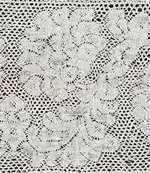
An example of Dutch lace called Cauliflower
or Chrysanthemum lace. This kind of thick, closely
worked, strong lace can be seen in many portraits of
the period which provided a contrasting effect to the
austere black of the sitter's costumes.
Lace, one of Europe's ancient crafts, represents one of the most extravagant elements in the history of clothing. Defined as an openwork fabric, it's patterned with holes either made by removing threads from a previously woven fabric or by incorporating open spaces directly within the fabric's design. True lace, which emerged in the late 15th and early 16th centuries, wasn't widespread until the era of Queen Elizabeth of England. Distinctly, true lace is crafted when a thread is looped, twisted, or braided with other threads without relying on a backing fabric. Historically, all lace was laboriously handmade, contributing to its high cost. Craftsmen utilized a plethora of materials including cotton, silk, flax and even metallic threads—spanning gold to copper—and occasionally, hair.
In Vermeer's painting, the depicted girl is evidently crafting bobbin lace. Analogous to how needle lace relates to embroidery, bobbin lace is akin to weaving. Within bobbin lace, threads are plaited, twisted and intertwined, producing solid portions reminiscent of woven fabric.
Bobbin lace garnered more admiration than its needle counterpart, particularly because of its lighter texture fitting seamlessly into Elizabethan attire. This lace was conducive to the prevalent manufacturing system: businessmen procured raw materials, distributing them to domestic workers who were compensated per completed piece. The businessman then sold the finished product, retaining the profits. Notably, bobbin lace involved craftsmen of both genders, and even fishermen, during their idle months, dabbled in its creation. However, the introduction of machine lace initially prompted lace-makers to venture into intricate designs, ones too complex for machinery, but eventually, this innovation almost entirely sidelined them. Known alternatively as bone-lace, bobbin lace owes this moniker to the historical use of bone-made bobbins. Observing Vermeer's lacemaker, one discerns her collar, presumably lace-made. Yet, the artist's restrained detailing only captures its sheer quality.
What kind of lace is the young lacemaker making?
So what kind of lace may the girl in Vermeer's painting actually making? Of course, we must take to account that Vermeer most likely did not paint exactly what he saw with photographic precision. However, an educated guess would be that she's making a relatively short piece of lace. This could be a geometric motif designed for non-continuous lace or a brief strip, destined to be affixed to a linen item, perhaps a petite tablecloth, runner, or cushion. It's evident she isn't undertaking an intricate pattern or extensive non-continuous lace, as such works would necessitate a larger collection of bobbins and likely the use of a "bolster" pillow.
Dutch women in the 17th-century household

A Woman Reading a Letter and a Woman Sweeping
Pieter Jansessens Elinga
c. 1670
Oil on canvas, 83.7 x 100 cm.
Stadelsches Kunstinstitut, Frankfurt am Main
From both anthropological and architectural perspectives, homes gained significant prominence in the latter half of the 17th century in the Netherlands. Artistic representations of Dutch domestic life burgeoned, with women frequently at the forefront. These depictions resonated with key values in Dutch society, emphasizing family, privacy, intimacy, comfort and luxury. A paradigm shift saw the domestic sphere emerging as the domain of women while the newly delineated public realm was seen as the preserve of men.
Vermeer predominantly depicted women immersed in refined leisure activities such as playing musical instruments, writing or reading. These portrayals likely underscored their literacy. Although pictorial traditions suggest the letters these women peruse revolve around romantic themes, they simultaneously highlight an evolving ideal of an educated domestic woman. Notably, Vermeer depicted women engaged in work only twice: in his early work The Milkmaid and the later piece The Lacemaker.
Gary Schwartz and Trudy van den Oosten, through an analysis of 3,340 paintings spanning Dutch, Flemish, Italian and Spanish origins, found that male figures constituted about 74% while women and children made up 19% and 7% respectively. Compared to his contemporaries, Vermeer depicted women with greater frequency. Yet, diverging from them, his interiors remained devoid of families, children or elderly individuals.
Certain theorists have provocatively posited that women played a central role in Vermeer's life. This is grounded not only in the recurrent female themes in his paintings but also in anecdotes about his assertive mother-in-law, a home populated by daughters and an assertive maid. Some interpretations, rooted in his depiction of subjects, suggest he was either apprehensive of women or an emotionally remote father. However, it seems more plausible that the unique representation and proportion of women in his works align with deliberate artistic intentions rather than personal or psychological motivations. This conjecture is reinforced by instances where the personal lives of several Dutch artists starkly differ from their chosen artistic subjects.
Salvador Dalí & The Lacemaker
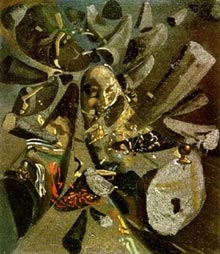
The Paranoiac-Critical Study
of Vermeer's "Lacemaker"
Salvador Dalí
1954–1955
27.1 x 22.1 cm.
Solomon R. Guggenheim Museum, New York
The art of Vermeer had minimal influence on painters of his era, and his name and work remained nearly obscure until the mid-19th century. While he was predominantly regarded as a painter's painter in art circles during the early 20th century, few artists found inspiration in his work. Notably, Vermeer's seemingly simple painting received high praise from Salvador Dalí, one of the most exuberant artists of all times.
Dalí wrote: "the first time I saw a photograph of [Vermeer's] Lacemaker and a live rhinoceros together, I realized that if there should be a battle, The Lacemaker would win, because The Lacemaker is morphologically a rhinoceros horn."
One of Dalí's objectives was to rejuvenate modern painting. His representational approach and his continuous veneration of the Old Masters not only provoked fellow Surrealists in the 1930s but also positioned him in stark contrast to the avant-garde's inclination toward abstraction.
Throughout the annals of art history, artists consistently endeavored to understand form and to simplify it into fundamental geometric shapes. Leonardo frequently leaned towards egg shapes, Ingres favored spheres, while Cézanne was drawn to cubes and cylinders. Dalí believed that all curved surfaces of the human body shared a geometric characteristic, specifically resembling a cone with its rounded tip arcing towards the sky or the ground: the rhinoceros horn.
Upon this revelation, Dalí examined his own compositions and recognized that each could be distilled into representations of rhinoceros horns.
Furthermore, Dalí identified what he described as "latent rhinocerisation" within the compositions of esteemed artists. In Dalí's perspective, "The Lacemaker is a representation of a rhinoceros horn (or a collection of horns), and the actual horn of the rhinoceros symbolizes The Lacemaker. The painting holds dominance over the living rhinoceros because it encapsulates these lively, spiritualized horns, in contrast to the rhinoceros that possesses only the solitary modest horn symbolizing The Lacemaker on its snout."
A reproduction of The Lacemaker adorned the wall of his father's office and had captivated Dalí for numerous years. In 1955, he sought authorization to access the Musée du Louvre with his painting materials to craft a replica of The Lacemaker.
Dalí explained, "Up till now, The Lacemaker has always been considered a very peaceful, very calm painting, but for me, it is possessed by the most violent aesthetic power, to which only the recently discovered antiproton can be compared."
Vermeer's faces

A Woman Spinning (detail)
Gerrit ter Borch
Oil on panel, 33.5 x 29 cm.
Museum Boijmans Van Beuningen, Rotterdam
The faces in Vermeer's paintings are competently rendered, yet when juxtaposed with those by his contemporary Gerrit ter Borch, one of the Netherlands' most distinguished and financially successful painters, differences emerge. While Ter Borch's formal portraits may seem sophisticated yet tempered by traditional constraints, the individuals in his genre interiors exude genuine vitality. They convey emotions spanning from profound doubt and silent desperation to genuine hope and introspection. His portrayals of both the working class and the elite, in their subtlety, parallel the portraits of Rembrandt.
Contrasting Vermeer's Lacemaker with Ter Borch's Spinner, where both depict women engrossed in household tasks, the distinction in their portrayal is readily evident. In Ter Borch's piece, the spinner's task captivates her mind, yet she retains her distinct identity. Her facial features are approached with tenderness, warmth and esteem. For Ter Borch, the emotions of his palpable subject and the craft of painting hold equal value.
Conversely, in Vermeer's Lacemaker, the observer's attention methodically traverses the entire painting, gradually deciphering the nuances of its composition, in which the girl's countenance is merely one element. We are skillfully steered by the elegant and masterful brush strokes, coupled with the captivating compositional cadence. The limited facial details Vermeer allows us to discern manifest as contrasting shades, with minimal transition in their shaping. The orientation of the girl's eyes and the alignment of her fingers with the taut threads coalesce at a singular point, where her lace materializes stitch by stitch. The essence of the craft is conveyed more profoundly than the individuality of the lacemaker. She is evident, yet remains elusive.
Domestic labor from a female point of view

A Woman Cleaning
Geertruydt Roghman
After c. 1640
Engraving, 235 x 187 mm.
Metropolitan Musem of Art, New York
During the 17th century, the Netherlands offered the most promising prospects for female painters. A significant portion of these female painters were daughters of established painters. Those who weren't typically belonged to families of intellectuals or minor nobility with connections to the art world. Many were the eldest daughters or came from families without sons, leading their fathers to invest unusually in their artistic careers. It was common for women painters to produce fewer works or cease painting once married—a trend also observed among male painters who married affluent women.
Due to societal constraints preventing women from studying the male nude, a foundation for large-scale history paintings featuring partially or fully undressed figures, many women gravitated towards other genres like still life, genre scenes, or portraiture.
Among the notable female painters of the Netherlands were Judith Leyster, known for her figure and genre interiors, and Rachel Ruysch, who catered to an international audience. While a discernible feminine touch might be perceived in their works—a perception possibly influenced by knowledge of their gender—both adhered to the prevalent genre norms, utilizing symbolism or moral allegory akin to their male counterparts. Consequently, their works don't necessarily offer deep insights into the lived experiences of these women artists.
Geertruydt Roghman, from an artistic Amsterdam family, stands out as one of the few female painters capturing domestic tasks from a woman's vantage point. She's primarily recognized for her suite of engravings titled Household Tasks, encompassing activities such as sewing, spinning, possibly reading, cooking and cleaning utensils. Particularly striking in this suite are the kitchen scenes depicting solitary maids viewed from the rear.
Roghman's prints proffer a somber, unembellished perspective on domestic life. The figures in her kitchen scenes are notably devoid of distinguishing characteristics. Could Roghman be emphasizing the rigors of domestic tasks? One commentator suggests that Roghman presented women "as autonomous entities rather than figures subordinated to patriarchal views. Therefore, women aren't depicted performing tasks to earn male validation." From an objective standpoint, contrasting Roghman's themes with those of her male contemporaries like Vermeer and Gerrit Dou presents a challenge. However, it's essential to recognize that while prints catered to a wide audience, Vermeer tailored his pieces for specific collectors.
Regardless, in the context of Dutch art and literature, the household, familial bonds and the domestic duties of the housewife were venerated as the pillars of Dutch society post-1650. Domestic responsibilities weren't devalued. It's challenging to find more uplifting depictions of female labor than those seen in Vermeer's Milkmaid or Lacemaker.
Listen to period music
![]() Unico Wilhelm van Wassenaer (1692–1766)
Unico Wilhelm van Wassenaer (1692–1766)
Concerto Armonico no. 5 [900 KB], A tempo comodo (con sordino)
http://www.amazon.com/Wassenaer-Concerti-Unico-Wilhelm-van/dp/B00006RHPO/ref=sr_1_2?ie=UTF8&s=music&qid=1255264489&sr=1-2

